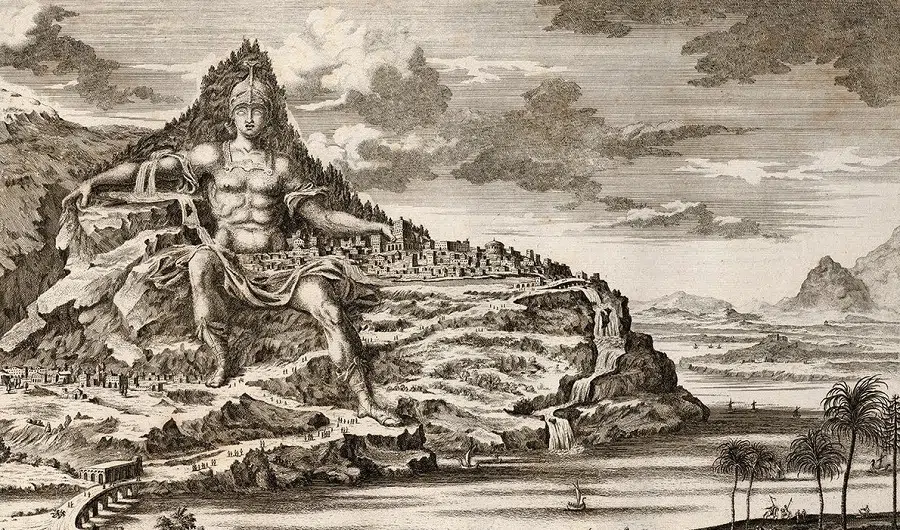
Alexander the Great is said to have rejected a colossal project to sculpt Mount Athos, as had been proposed by his architect and technical advisor, Dinocrates.
The architectural proposal, which, had it been carried out, would perhaps have been the eighth wonder of the ancient world, involved carving into the flank of Mount Athos a colossal image of Alexander holding a small city in one hand and with the other holding a gigantic pitcher from which a river poured into the sea.
Athos is a mountain in the distal part of the eponymous Athos peninsula and is, nowadays, an important center of Eastern Orthodox monasticism in northeastern Greece.
Dinocrates of Rhodes (last quarter of the 4th century BC) was a prominent architect of his time. He is known for his plan for the city of Alexandria, the monumental funeral pyre for Hephaestion and the reconstruction of the Temple of Artemis at Ephesus, as well as other works.
The ambitious proposal described in a book by Vitruvius, a Roman architect and engineer during the 1st century BC, was politely rejected by Alexander the Great.

The Macedonian king saw the plan when Dinocrates, trusting in his projects and his ingenuity, marched from Macedonia to a meeting with Alexander.
Dinocrates vowed to transform Mount Athos into Alexander the Great’s image
In Vitruvius’ book, Dinocrates says: “I am Dinocrates, architect of Rhodes, and I work on projects and services worthy of your greatness. I can transform Mount Athos into the figure of a manly statue; in his left hand he holds the walls of a large city and in his right a huge patera that collects the waters of the rivers that flow in that mountain, in order to pour them into the sea from his own hand.”
Alexander was pleasantly satisfied with the description of the project, and, at once, he asked if, near the planned city, there were fields that supplied it with wheat harvests.
When Dinocrates told him that the supply was not possible, Alexander replied, according to Vitruvius:
Dinocrates, I carefully observed the magnificent structure of your project and I like it. But just as a newborn baby without milk cannot develop, so a city can not grow, if it does not have the fields that accompany it.
Regarding your plan, you deserve compliments, but the location of the city should be disapproved. It is my wish that you stay by my side because I want to use your work.
Urban planner of Alexandria, Egypt
The story, as recorded by Vitruvius, has been dismissed by some scholars. The excessiveness of the project makes it hardly credible. In addition, Dinocrates demonstrated in the planning of Alexandria and other works a talent incompatible with the fatuity of this project as Vitruvius describes it, according to alexandreion.wordpress.com.
Dinocrates no longer left the king and followed him to Egypt, where in 332 BC Alexander appointed him as director of the surveying and urban-planning work for the city of Alexandria.
Vitruvius says:
When Alexander observed that he found a port protected by nature itself and an extraordinary market, in addition to the fields planted with wheat that covered the whole of Egypt, as well as the enormous advantages provided by the impressive Nile River, he ordered that he found there [a] city, named Alexandria, in honor of his own person.
In Babylon, Dinocrates designed the funerary monument to Alexander’s general Hephaestion, who died in 324 BC, which was described by Diodorus Siculus, Arrian, Strabo, Plutarch, and others. It was built of stone in imitation of a Babylonian temple, six stories tall, and entirely gilded.
Dinocrates was also involved in reconstructing the Temple of Artemis, one of the seven wonders of the world, which had been destroyed by Herostratus in an act of arson on July 21, 356 BC. This was the same night, it was said, that Alexander was born.
He also worked on an incomplete funerary monument for Alexander’s father, Philip II. Other works include several city plans and temples in Delphi and Delos among other Greek cities.
See all the latest news from Greece and the world at Greekreporter.com. Contact our newsroom to report an update or send your story, photos and videos. Follow GR on Google News and subscribe here to our daily email!



